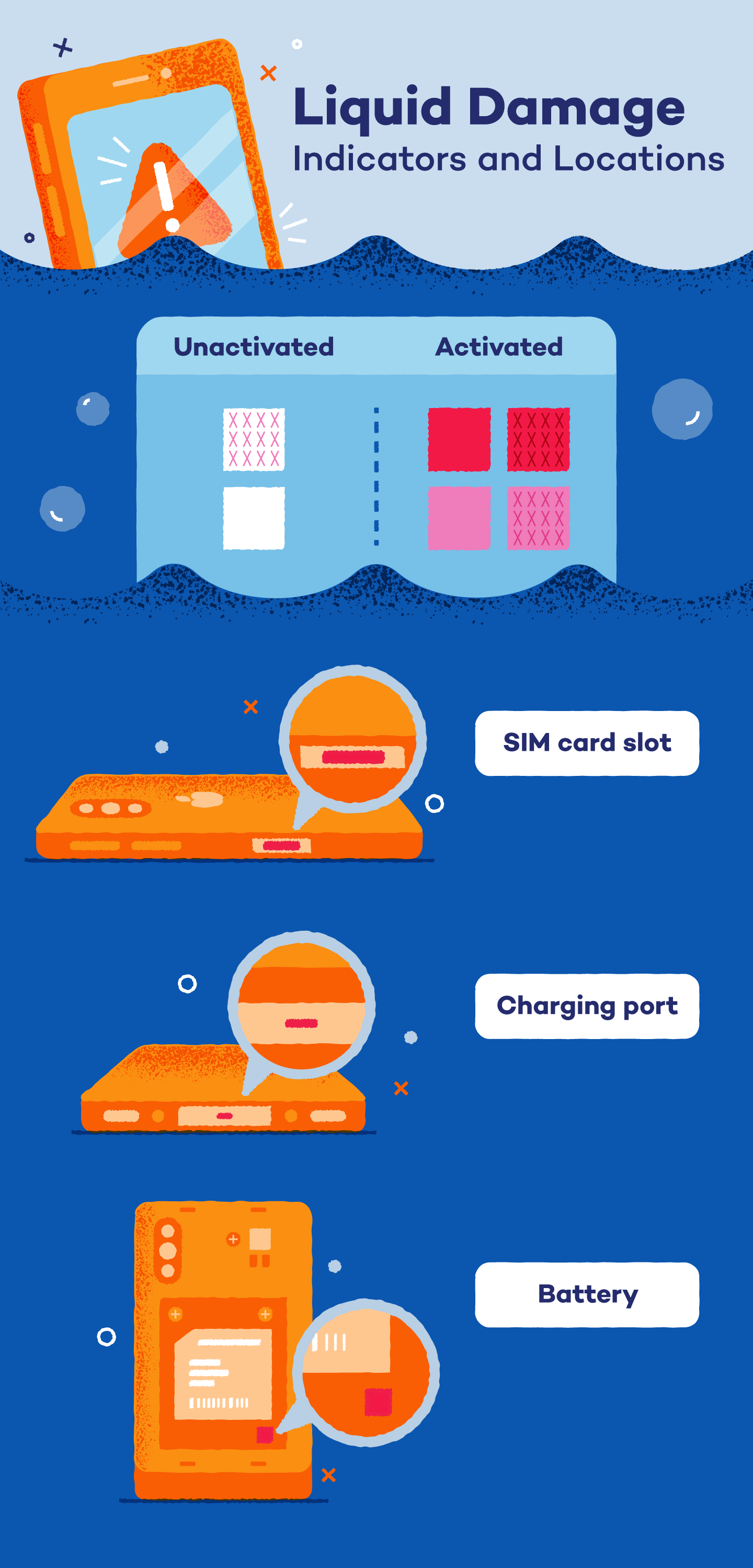Here’s how to fix a phone that fell in water:
1. Take your phone out of the water.
2. Power off your phone.
3. Disassemble any detachable parts, such as the phone case and SIM card.
4. Use a soft cloth to gently dry the phone’s surface.
5. Place your phone in a sealed container with silica gel packets.
6. Let your phone dry for 24-48 hours without turning it on.
7. Power it on to check if it works, or consult a repair professional.
Few experiences match the heart-stopping panic that comes with seeing your beloved phone take an unexpected plunge into water (apart from, say, discovering your phone has a virus ). Whether it’s a poolside mishap, a bathroom fiasco or an unfortunate encounter with nature’s elements, water damage is a dreaded yet common occurence.
So can water-damaged phones be fixed? With timely action and the right approach, there’s a chance to breathe life back into your waterlogged device.
In this guide, we’ll walk you through how to fix a water-damaged phone in seven easy steps, along with how to recognize signs of water damage.
How to Get Water Out of Your Phone
Accidentally dropped your phone in water? Don’t worry — here is how to save a phone from water damage.
Step 1: Take Your Phone Out of the Water
Maybe it’s obvious, but the first step to fix a phone with water damage is take it out! Every second you wait to get your smartphone out of the water, there’s a higher chance of your device filling up with water, lowering its chance of recovery.
Step 2: Power Off Your Phone
As soon as you’ve rescued your phone from the danger zone, check whether it’s still powered on; if it is, immediately power it off .
By immediately turning off your phone after it gets wet, you cut off the power source and stop the flow of electricity through the device. This reduces the chances of short circuits, prevents further damage from occurring and gives you a better chance of recovering your phone.
Step 3: Disassemble Any Detachable Parts
After powering down your phone, disassemble any detachable components, such as the phone case, SIM card and battery, to evaluate the extent of damage and prepare them for separate drying.
For iPhone users: Removing the battery requires a complete disassembly, which professionals should undertake. Only attempt this if you have the necessary expertise.
Step 4: Blot Off Excess Water
Once your phone has been taken apart, use a dry cloth or paper towel to blot excess water from your phone pieces. Make sure you do this gently, dabbing rather than rubbing, to avoid any further damage to your phone.
Step 5: Soak Up the Moisture
After drying the surface of your phone, it’s time to tackle the moisture inside. While the popular rice method (putting the wet phone in rice) is often suggested, it’s not the most effective way to remove water.
A better option is to place your phone components in a sealed container with silica gel packets — the moisture-absorbing packets found in new shoes or pill bottles. These are specifically designed to draw out moisture and work faster than rice.
If you don’t have silica gel on hand, you can purchase it online or use a fan or air conditioning vent as a temporary solution while waiting.
Step 6: Wait It Out
Leave your phone components in your chosen drying setup for at least 24-48 hours. This allows sufficient time for moisture to evaporate, minimizing the risk of internal damage. The exact duration depends on the drying method and the severity of water exposure.
- For silica gel packets, 24 hours is typically sufficient.
- If you’re using rice or a fan, aim for 48 hours for better results.
Brief exposure to water may require less time, but fully submerged devices might need extended drying. Resist the urge to power on your phone too soon, as this can lead to permanent issues or worsen existing iPhone water damage.
Step 7: Power On and Test
After the initial drying period, you can test your phone to see if it’s functional. If your phone has a normal boot-up, functional touch screen and clear audio, you may be in the clear!
If you encounter any issues, such as a distorted screen, unusual noises or failure to turn on, it’s wise to seek professional help to avoid exacerbating the damage.
How to Get Water Out of Your Phone Camera Lens
If you see fog or water inside the lens, turn off your phone immediately to prevent damage. Then, place it in a sealed bag with silica gel packets for at least 24-48 hours to draw out moisture.
Avoid using heat (like a hair dryer) as it can warp components. If the moisture doesn’t clear up or the camera stays foggy, take it to a repair shop — you might need a professional cleaning or replacement.

You can also spot potential water damage by keeping an eye out for any signs that imply your phone’s internal workings have been harmed or if your phone screen has damage.. Here’s how you can tell if your phone has water damage:
- Foggy display: Condensation under the screen or within the camera lens can indicate water has entered the device.
- Erratic behavior: If your phone is behaving unpredictably, like apps opening and closing on their own, it might be a result of water affecting the internal circuits.
- Slow performance: Water damage can cause the phone’s processor to function poorly, leading to slow performance.
- Touchscreen problems: Unresponsive touch or erratic touchscreen behavior can be linked to water exposure.
- Muffled sound: If you notice decreased audio quality or muffled sound, it could indicate water damage affecting the speaker or microphone.
- Charging problems: Water damage can interfere with the charging port, causing issues with charging or connecting to a computer.
- Battery draining quickly: Water damage might lead to increased power consumption and a faster-draining battery.
- Inconsistent power: If the phone powers on and off on its own or struggles to stay powered on, water damage could be a contributing factor.
- Discoloration: If the internal components have been affected by water, you might notice areas of discoloration on the motherboard or other internal parts.
- Corrosion: Green or white spots on the internal components can indicate the presence of corrosion due to water exposure.
If you suspect your phone has water damage, it’s best to power it off immediately and avoid turning it on until it’s thoroughly inspected and dried. If the signs of water damage are severe or the phone isn’t functioning properly after drying, seek professional repair assistance to prevent further damage.
How to Remove Water From Your Charging Port
If water has entered your phone’s charging port, you need to dry it out properly to avoid electrical damage. Follow these steps:
- Turn off your phone: Immediately power off your phone to prevent short circuits while handling the charging port.
- Gently shake your phone: Hold your phone with the charging port facing downward and gently shake it to dislodge any excess water.
- Use a dry cloth: Dab the port area with a soft, dry cloth to absorb visible moisture. Avoid inserting the cloth into the port itself.
- Allow it to air dry: Place your phone in an upright position with the charging port facing downward in a well-ventilated area. Let it air dry for at least 30 minutes.
- Avoid using compressed air: Do not blow into the port or use compressed air, as this can push moisture further inside the phone.
- Try a drying agent: If you suspect lingering moisture, use silica gel packets to help absorb it. Place your phone in a sealed container with the packets for several hours.
- Check before plugging in: Once the port feels dry, inspect it carefully before attempting to charge your phone. If in doubt, wait longer or seek professional assistance.
Follow the same steps if you’re wondering what to do if water gets in your phone speaker.
FAQ
If you’re in the process of discovering how to remedy a water-damaged phone, you might find yourself with numerous other questions. Here are some other frequently asked questions often raised about addressing water damage on phones.
How Long Can a Phone Last in Water?
In most cases, if a phone is submerged for even a few seconds, you should treat it as potentially damaged and take appropriate steps to assess and address any water exposure.
Some modern smartphones are designed to be water-resistant or waterproof to a certain degree. This means they can withstand brief submersion or splashes, but even these phones have limits to their water resistance.
For example, Apple claims its most recent iPhone models have a rating of IP68, which essentially means they can stand a maximum depth of 6 meters for up to 30 minutes in water.
The longer the phone remains in the water, the higher the likelihood of irreversible damage. It’s important to act quickly to mitigate potential harm and improve the chances of successful recovery.
Does Rice Fix Water Damage?
Rice is a popular DIY method for drying out a water-damaged device, and it can help, but it’s not the most effective solution and doesn’t guarantee success.
While rice can absorb some moisture from the surrounding environment, it’s not particularly effective at drawing moisture out of the intricate components of a smartphone. Modern devices have tightly sealed compartments where moisture can become trapped, and rice might not be able to reach those areas.
Rice is also very starchy, which can leave behind dust and residue that could potentially cause further issues or make it difficult to clean later on. You also risk grains of rice getting stuck into your device’s ports and connections, which can be quite challenging to remove , as the rice swells when exposed to water.
Can You Blow-Dry Water Out of Your Phone?
If possible, avoid using a blow dryer to remove water from a water-damaged phone. While it might seem like a logical approach, there are significant risks associated with this method.
Instead of evaporating the moisture, a blow dryer might push the water deeper into the phone’s crevices , potentially causing it to spread to areas that were previously dry.
Additionally, blow dryers emit heat that can potentially cause further damage to the delicate components inside your phone. High temperatures in your phone can lead to melted plastic, warped components or even circuitry damage.
Why Does My Phone Power Off by Itself?
If your phone is randomly turning off, it’s usually due to a battery issue, software glitch or hardware problem. Here are a few common reasons:
- Battery issues: Worn-out or damaged batteries often can’t hold a charge and may cause random shutdowns.
- Overheating: Phones shut off automatically when they get too hot to prevent internal damage.
- Software glitches: Bugs from recent updates or faulty apps can trigger unexpected power-offs.
- Physical damage: Drops or water exposure can mess with internal components and cause instability.
Quick fixes to try:
- Update your phone’s software.
- Uninstall suspicious or recently added apps.
- Check your battery health in settings or with a battery health app.
- If it keeps happening, take it to a technician for a hardware check.
How Long Does It Take for Water to Get Out of Your Phone?
It usually takes 24 to 48 hours to dry out a phone entirely using the proper method — like sealing it in a bag with silica gel packets. Rice is a common DIY fix, but it’s less effective and slower.
The actual time depends on how much water got in and where it reached. If your phone was fully submerged or water got into key components like the screen or charging port, it may take longer — or not fully recover without repairs.
How Long Does It Take for Water to Dry in a Phone Charging Port?
Water in the charging port usually takes a few hours to one full day to dry completely, depending on how much got in and the humidity in your environment. To speed things up, power off your phone and stand it upright in a dry, well-ventilated spot.
Take Protective Measures to Safeguard Your Phone
A water-damaged phone may seem like saying, but with this guide on how to get water out of your phone, you can rescue your device. But remember: Phone protection goes beyond physical accidents.
Just as you need to keep your device’s hardware out of harm’s way, you also need to protect the personal data it contains. Panda Dome provides tools to fend off digital risks, offering comprehensive solutions like securing personal data and shielding online transactions.







